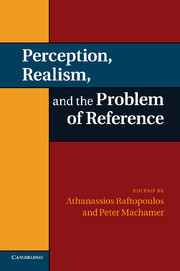
-
Select format
-
- Publisher:
- Cambridge University Press
- Publication date:
- 05 May 2012
- 12 April 2012
- ISBN:
- 9780511979279
- 9780521198776
- 9781107414648
- Dimensions:
- (228 x 152 mm)
- Weight & Pages:
- 0.62kg, 298 Pages
- Dimensions:
- (229 x 152 mm)
- Weight & Pages:
- 0.4kg, 300 Pages
- Subjects:
- Life Sciences, Philosophy of Science, Cognitive Psychology, Philosophy
You may already have access via personal or institutional login- Subjects:
- Life Sciences, Philosophy of Science, Cognitive Psychology, Philosophy
Book description
One of the perennial themes in philosophy is the problem of our access to the world around us; do our perceptual systems bring us into contact with the world as it is or does perception depend upon our individual conceptual frameworks? This volume of new essays examines reference as it relates to perception, action and realism, and the questions which arise if there is no neutral perspective or independent way to know the world. The essays discuss the nature of referring, concentrating on the way perceptual reference links us with the observable world, and go on to examine the implications of theories of perceptual reference for realism and the way in which scientific theories refer and thus connect us with the world. They will be of interest to a wide range of readers in philosophy of science, epistemology, philosophy of psychology, cognitive science and action theory.
Contents
Metrics
Altmetric attention score
Full text views
Full text views help Loading metrics...
Loading metrics...
* Views captured on Cambridge Core between #date#. This data will be updated every 24 hours.
Usage data cannot currently be displayed.
Accessibility standard: Unknown
Why this information is here
This section outlines the accessibility features of this content - including support for screen readers, full keyboard navigation and high-contrast display options. This may not be relevant for you.
Accessibility Information
Accessibility compliance for the PDF of this book is currently unknown and may be updated in the future.


